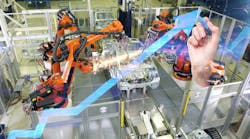>> Electronic Design Resources
.. >> Digital Editions
.. .. >> Top Stories of the Week
.. .. .. >> 2021 Electronic Design Forecasts
This article appeared in Machine Design and has been published here with permission.
According to a market report published by Allied Market Research, the automotive robotics industry reached $6.63 billion in 2019 and is expected to reach $13.6 billion by 2027. Many factors will both hinder and aid the growth of the industry in the next decade.
Many global manufacturing leaders agree that the adoption of IIoT—robotics included—is a long road that involves implementing automation incrementally. The prominence of automation in the automotive sector has been fueled by the increased need for accuracy, which robotics can provide. The global demand for increased productivity and speed has also led the charge for robotics in the automotive industry.
In 2020, a rising theme in global manufacturing was the concept of the factory of the future, or a fully connected factory. The growth of AI-integrated robotics and other data-driven processes will lend a hand to robotics adoption, providing a broader use case for purchase.
A non-financial issue in robotics adoption revolves around safety concerns for the worker in a robotic environment. Robots have been used in automotive production for more than 70 years; several legal safety precedents have been established in that time. In October 2020, the American Bar Association Section of Science & Technology Law hosted a series of presentations on legal implications of advanced robotics in automotive manufacturing. Robot safety standards are continually evolving for more complex and specialized environments.
The largest segment of the automotive robotics market belongs to the robotic arm, which is expected to grow at a CAGR of 23.5% during the forecast period. The highest-growth application in the market is expected to be automotive painting, which will reflect a CAGR of 20.8%.
The COVID-19 pandemic hindered the progress and production of robots, which negatively affected the market in early 2020. COVID also halted automotive production and disrupted the supply chain. The market regained some traction when robotics were being used in plants to “fill the gap” between socially distanced workers.
Industrial robots are large and very expensive, which lessened grip of robotics in the automotive space in the past, but the use of them is expected to become more prevalent in post-pandemic automotive production.
